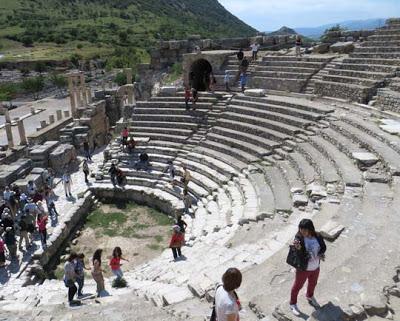
The Ancient Greek City of Ephesus, Temple of Hadrianus
Until I visited Turkey, I never realized the breadth of the ancient Greek and Roman empires. A little over a year ago, after spending a week in Istanbul for a writer’s workshop, I signed up for an add-on tour of Ephesus and other sights in Selkuk, plus a trip to the ancient city of Hierapolis and thermal baths of Pamukkele. We flew from Istanbul to Izmir (the ancient Greek city of Smyrna) and boarded a bus from there to Selkuk, about an hour’s scenic ride along a river valley to the south. There we spent two and a half days, jam packed with sightseeing.
View of Selkuk from the path to the Cave of the Seven Sleepers on Mount Pion
Our first day included a visit to the Temple of Artemis, the caves of the Seven Sleepers, the Ephesus Museum (where many of the sculptures from the the ancient city are displayed), the House of the Virgin Mary (said to be the final resting place of Mary the mother of Jesus), and finally, a tour of the ancient city of Ephesus itself, which is just two kilometers outside the city. Our English speaking guide narrated as we went. Here are some selected photos from our first day:
Statue on grounds of the House of the Virgin Mary

Beginning of the mile-long ancient road through the city of Ephesus. We walked from from parking lot at the top of the hill, down through the city to what had been the ancient port, now silted in, passing the remains of temples, fountains, public baths and lavatories, amphiteaters, a library and more along the way.

Facade of the Library of Celcus at Ephesus. It initally housed 12,000 books. The first human settlements at Ephesus were around 6,000 B.C. and it gradually grew into a city/state. Alexander the Great conquered Ephesus in 304 B.C. In the Augustan period of the Roman Empire, Ephesus was one of the most important cities of Roman Asia. The library was built after the death of Celcus, the Roman Governor of Asia Minor, who died in 114 A.D.

Ephesus Museum in Selkuk. Sculpture from one of the fountains at Ephesus. In ancient times three rivers provided water at the rate of 100 liters per second. Water was used for public baths and lavatories, fountains, and for daily use.

Ephesus, upper amphitheater, the Odeion, with the Stoa Basileios (the Royal Walk) to the left.

Mosaic floor, Ephesus
A report of our excursion to Pamukkele will be in a future post.